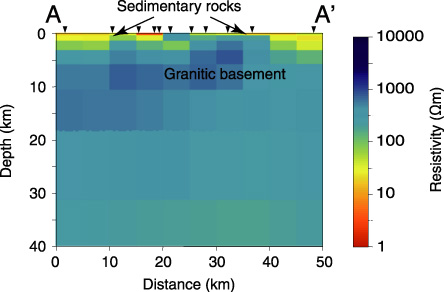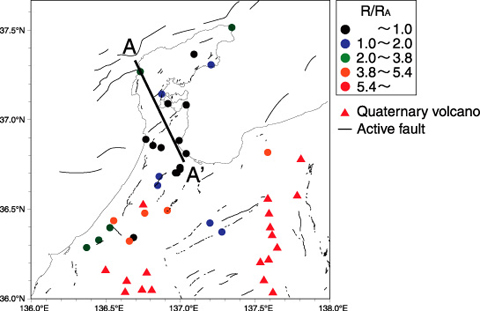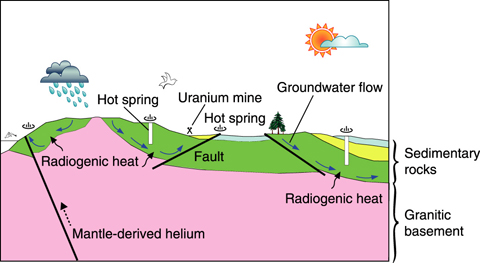
Fig.2-14 Electrical resistivity structure beneath the Noto Peninsula

Fig.2-15 Geographical distribution of helium isotope ratios in and around the Noto Peninsula

Fig.2-16 Schematic illustration of the hydrothermal system in the Noto Peninsula
Hydrothermal system related volcanism is one of the most important factors affecting the long-term stability of a geological disposal system, because it could cause significant changes in groundwater flow and temperature. Therefore, we have been developing magma and high-temperature fluid detection technologies to evaluate the possibility of renewed volcanism in a given site. For this purpose, we characterized a plausible heat source of high-temperature hot springs in the Noto Peninsula using magnetotelluric (MT) soundings and measurement of the helium isotope ratio (3He/4He) of hot springs.
It has long been recognized that the Noto Peninsula is unusual for a non-volcanic region, in that it has anomalously high-temperature hot springs similar to those in volcanic regions. Electrical conductivity is the physical property most sensitive to the configuration of magma. According to MT soundings in this region, the electrical resistive zone corresponding to granitic rock is visible below a depth of several km; however, conductive body anomalies representing magma do not exist beneath the Noto Peninsula (Fig.2-14). The observed 3He/4He ratios of most hot springs in this region are similar to that of the atmospheric value (Fig.2-15). These results indicate that the high temperature of the hot springs in this region is not due to the supply of heat from magma. What, then, is the heat source of the amagmatic hydrothermal system in the Noto Peninsula? The granitic rocks revealed as the electrical resistive zone contain elevated concentrations of U, Th, and K. These findings indicate that a plausible heat source for the high-temperature hot springs can be attributed to radiogenic heat production derived from the decay of U, Th, and K within the granitic basement, and heat transfer with groundwater advection (Fig.2-16).